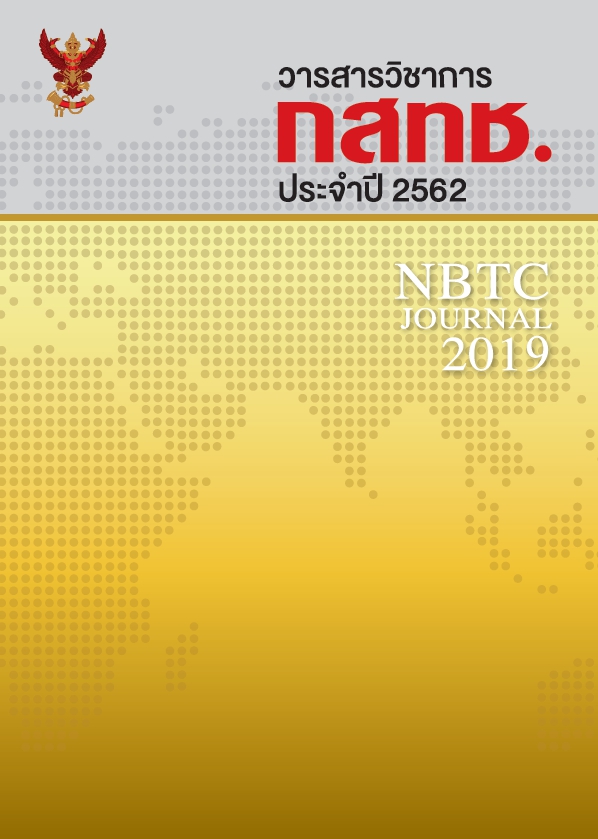ทิศทางและความท้าทายในการเจรจาข้อตกลงว่าด้วยการค้าบริการโทรคมนาคม (TiSA) ในยุคเศรษฐกิจดิจิทัล
คำสำคัญ:
ข้อตกลงว่าด้วยการค้าบริการ, การเปิดเสรีการค้าบริการโทรคมนาคม, ภาคผนวกโทรคมนาคมบทคัดย่อ
ข้อตกลงว่าด้วยการค้าบริการ (Trade in Services Agreement หรือ TiSA) เกิดจากการรวมตัวของประเทศสมาชิกจำนวน 23 ประเทศเพื่อเจรจาปรับปรุงหลักเกณฑ์เกี่ยวกับการเปิดเสรีการค้าบริการระหว่างประเทศให้มีประสิทธิภาพมากขึ้นและสอดคล้องกับบริบทในยุคเศรษฐกิจดิจิทัลหลังจากที่กรอบการเจรจาข้อตกลงองค์การการค้าโลกหยุดชะงักไม่สามารถบรรลุตามเป้าหมายได้ โครงสร้างและบทบัญญัติหลักของข้อตกลงว่าด้วยการค้าบริการอิงข้อตกลงทั่วไปว่าด้วยการค้าบริการ (GATS) ภายใต้กรอบขององค์การการค้าโลก
กิจการโทรคมนาคมถือเป็นภาคบริการที่เป็นยุทธศาสตร์สาขาหนึ่งที่ข้อตกลงว่าด้วยการค้าบริการ (TiSA) ได้บรรจุไว้เป็นภาคผนวก โดยมีวัตถุประสงค์เพื่อวางหลักเกณฑ์เกี่ยวกับการเปิดเสรีและกำกับดูแลกิจการโทรคมนาคมของประเทศสมาชิกให้มีความโปร่งใส ลดการกีดกันทางการแข่งขันที่ไม่จำเป็น และอิงกลไกตลาด เพื่อให้สอดคล้องกับบริบทของตลาดและความก้าวหน้าทางเทคโนโลยี แต่ในปัจจุบันการเจรจาในเรื่องนี้ยังไม่ได้ข้อยุติในหลายประเด็น เนื่องจากข้อตกลงว่าด้วยการค้าบริการยังขาดความสมดุลในการเสริมสร้างขีดความสามารถในการแข่งขันและเอื้อต่อประเทศพัฒนาแล้วที่เป็นเจ้าของเทคโนโลยีและกลุ่มบรรษัทข้ามชาติด้านเทคโนโลยี ประเทศไทยในฐานะเป็นส่วนหนึ่งของระบบเศรษฐกิจโลกจึงควรต้องมีความพร้อมในการรับมือกับความท้าทายในอนาคตนี้ บทความนี้เป็นการวิจัยเชิงคุณภาพโดยศึกษาจากเอกสาร (Documentary research)
เอกสารอ้างอิง
Elina, V. (2015).The Trade in Services Agreement (TISA): An end to negotiations in sight?, Retrived from European
Parliament, Directorate-General For External Policies, Policy Department Website: https://www.europarl.
europa.eu/RegData/etudes/IDAN/2015/570448/EXPO_IDA%282015%29570448_EN.pdf
European Commission. (2015, October 6-13). Report of the TiSA negotiation round. Retrieved from https://trade.ec.
europa.eu/doclib/docs/2015/october/tradoc_153917.15.pdf
Global Justice Now. (2016). What is TiSA and why do we need to stop it?. Retrieved from https://www.globaljustice.
org.uk/resources/what-tisa-and-why-we-need-stop-it
Gould, E. (2014). The Really Good Friends of Transnational Corporations Agreement. Retrieved from Public Services
International website: https://www.worldpsi.org/sites /default/files/documents/research/report_tisa_eng_lr2.pdf
Introduction
International Trade Union Confederation. (2016). All About TiSA: Everything you didn’t know about the Trade in
Services Agreement. Retrieved from https://www.ituc-csi.org/IMG/pdf/ituc-tisa-report_en.pdf
Jane, K. (2017). The Trouble with TiSA. The Trade in Services Agreement and how it threatens transport workers’
rights. Retrieved from the International Transport Workers’ Federation (ITF) and Friedrich-Ebert-Stiftung website :
and-how-it-threatens-transport-workers-rights/
Jane, K. (2017). TISA: the leaked core text. Retrieved from https://wikileaks.org/tisa/analysis /Analysis-of-20150424_
Core-Text/page-1/#pagination.
Nigel, C., & Stephen, E. (2016, June 6). Crafting an Innovation-Enabling Trade in Services Agreement. Retrieved
from Information Technology and Innovation Foundation website : https://itif.org/publications/2016/06/06/crafting-
innovation-enabling-trade-services-agreement
Sherry, S., Alexandros, R. & Jimena, S. (2016). Implications of the Trade in Services Agreement (TiSA) for
Developing Countries. [Discussion Paper]. Retrieved from German Development and Deutsches Institut für
Entwicklungspolitik Institute https://www.die-gdi.de/en/discussion-paper/article/implications-of-the-trade-in-
services-agreement-tisa-for-developing-countries/
Wikileaks. (2015). Initial Analysis of TiSA Telecommunications Annex. (July 2, 2015). Retrieved from
ดาวน์โหลด
เผยแพร่แล้ว
รูปแบบการอ้างอิง
ฉบับ
ประเภทบทความ
สัญญาอนุญาต
บทความที่ปรากฏในวารสารกิจการสื่อสารดิจิทัล เป็นลิขสิทธิ์ของสำนักงาน กสทช. ซึ่งสำนักงาน กสทช. เปิดโอกาสให้สาธารณะหรือบุคคลทั่วไปสามารถนำผลงานไปเผยแพร่ คัดลอก หรือตีพิมพ์ซ้ำได้ ภายใต้สัญญาอนุญาตแบบเปิด (Creative Commons: CC) โดยมีเงื่อนไขสำหรับผู้ที่นำผลงานไปใช้ต้องระบุอ้างอิงแหล่งที่มา (Attribution: BY) ห้ามดัดแปลง (NoDerivatives: ND) และต้องไม่ใช้เพื่อการค้า (NonCommercial: NC) เว้นแต่ได้รับอนุญาตเป็นลายลักษณ์อักษรจากสำนักงาน กสทช.
อนึ่ง ข้อความ ตาราง และภาพที่ปรากฏในบทความซึ่งได้รับการตอบรับให้ตีพิมพ์และเผยแพร่ในวารสารนี้เป็นความคิดเห็นของผู้นิพนธ์ โดยไม่ผูกพันต่อ กสทช. และสำนักงาน กสทช. หากมีความผิดพลาดใด ๆ ผู้นิพนธ์แต่ละท่านต้องรับผิดชอบบทความของตนเองแต่เพียงผู้เดียว ไม่เกี่ยวข้องกับ กสทช. และสำนักงาน กสทช. แต่ประการใด



